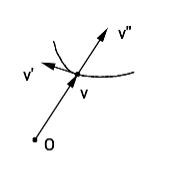For a diffeomorphism between two Euclidean lines, the derivative
is an invariant in the sense that to calculate the derivative we fix Euclidean coordinate systems on the domain and on the range and the calculated value will not depend on the choice of coordinate systems.
For a diffeomorphism between affine lines, things are not that simple, the calculated value of the derivative
will be dependent on the affine coordinate systems it is computed in. To find an invariant expression we look at the fundamental invariant of the affine line, the three-point ratio:
We put and
. Then
and the ratio of the images of the three points is then
and so the one-form is an invariant that measures how much the diffeomorphism deviates from being an affine transformation.
Now let be a coordinate on the range and thus
. We can express the derivatives of
as
and the invariant one-form can be reexpressed as . Each of the two quotients is invariant under affine coordinate changes so in fact any function
would define an invariant of the diffeomorphism, but it is only by taking the difference that the second order differentials cancel and we get an invariant that is a one-form on the tangent space.
Let’s carry out this calculation, which is in a sense the last calculation carried out backwards. Since the second differential of is
, we get
as expected.
Moving on to instead study a diffeomorphism between projective lines, we now want to see how the cross ratio
changes under the diffeomorphism. We put ,
,
and calculate that
. On the range space we want to make use of the availability of homogenous coordinates and define a lift of
to a vector
by
This lift has the property that the curve has constant angular momentum and thus the acceleration vector is parallel to the position vector
. The cross ratio can be calculated in homogenous coordinates as
We have that
The cross products become
and the cross ratio of the image points is
So we get a quadratic form, the Schwarzian derivative, that tells us how much the diffeomorphism deviates from being a projective transformation. The coefficient
is calculated as
and the Schwarzian derivative when directly expressed in derivatives of becomes
We have already given above the first and second derivative of expressed as differentials of
and
. The third derivative then can also be reexpressed as
and the Schwarzian derivative then becomes
Thus we see, just as in the affine case, that the invariant form for the diffeomorphism is a difference between two separately invariant higher order forms, one on the range and one on the domain.
We now define and
. For a composition of diffeomorphisms
, we get
and we have shown the cocycle condition for the Schwarzian derivative.


Pingback: Vortex dynamics | Curved Maths